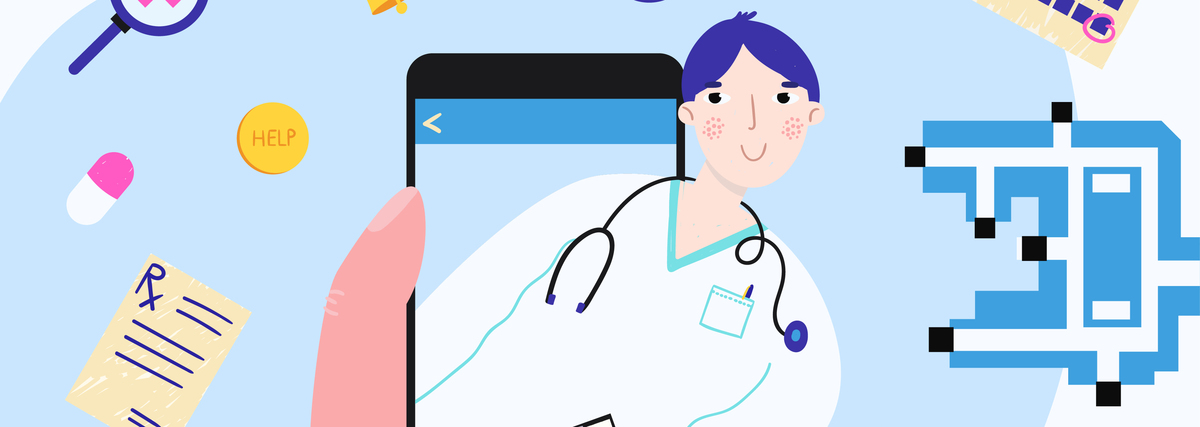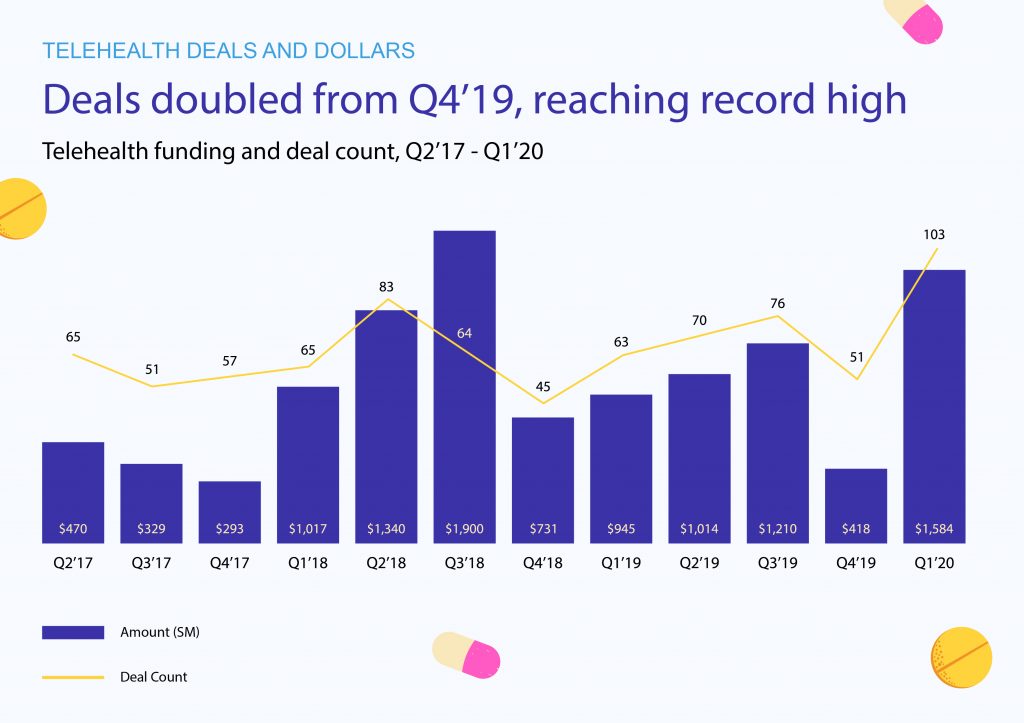Mobile Health: 8 Steps to Building an App

The modern healthcare industry is actively reaping the benefits of technological innovations. Among others, Forbes lists artificial intelligence (AI) and machine learning, wearables, virtual reality, and healthcare mobile apps trends as having the potential to transform medicine and healthcare.
Most people today depend on smartphones that make their day-to-day life simpler. Mobile healthcare applications can provide brilliant solutions. For example, they are helping both with basic monitoring, e.g., of nutrition levels and with tracking of chronic conditions like diabetes or epilepsy to prevent serious incidents. After mobile apps for easy food delivery, travel, and hotel booking, users have appreciated similar services for doctor appointments. Healthcare mobile apps also provide many people with access to professional medical consultations without leaving their homes, in addition to the lower cost of such ‘virtual visits.’ Such solutions could be literally life-savers in areas with no access to healthcare institutions.
In 2020, the coronavirus pandemic has dramatically impacted the lives of people, businesses, and whole industries. Healthcare was naturally one of the first affected. According to CB Insights, telemedicine, remote patient monitoring (RPM), and AI in healthcare experienced a nearly 300% boost in investment.

Worldwide quarantines required social distancing. While office workers resorted to Zoom meetings, doctors and healthcare institutions expanded their services with mobile health (mHealth) apps. The market exploded and is still growing.
If you are interested in the opportunity, this article provides an impromptu healthcare app development guide.
Basic Healthcare Application Development Steps
From a developer’s point of view, the steps to building an app for the healthcare sector are not much different from any other, e.g., a fitness app or messenger. The development of all mobile apps starts with conceptualization and ends with deployment and maintenance. In this article, we will focus on the healthcare-specific aspects of the process.
The following healthcare application development steps are non-linear, because some of them may occur simultaneously, overlap, and shift. For example, after a proper healthcare market and user research, an organization may recruit a team to build a mobile health app according to an approved specification. Alternatively, they can first hire healthcare app developers that will handle the project from the ideation stage to post-release support.
1) Market research
This step implies researching potential rivals, possible healthcare mobile apps trends, and looking for opportunities. For example, according to Statista, there were 45,478 mHealth apps in the Apple App Store as of the first quarter of 2020. It seems like a tremendous competition but in reality, most of them are various trackers for fitness, period, calorie, meditation, etc. A small part comprises legitimate telemedicine products, but their downloads rate couldn’t compete with any of those trackers.
The majority of healthcare mobile apps gravitate towards three categories of users: medical administration, personnel, and patient care. These three categories have their subcategories that healthcare app developers might consider.
| Apps for Administration | Apps for Personnel | Apps for Patient Care |
| 1. Doctor marketplace 2. Nurse marketplace 3. Practice management 4. Inventory management 5. Billing 6. Clinical communication 7. Enterprise resource planner (ERP) for hospitals | 1. Remote patient monitoring (RPM) 2. Appointments management 3. Electronic medical records (EMRs) 4. Electronic health records (EHRs) 5. Drug reference 6. Diagnosis 7. Telemedicine | 1. Hospital selection and appointment management 2. Telehealth 3. Health networking 4. Mental health 5. Medication reminders 6. Period tracker 7. Pharmacy 8. Healthy lifestyle |
It’s vital for healthcare app developers to search and explore what the market offers for their specific problem and how the existing solutions work. They should examine what has been developed and how adequately these apps are fulfilling consumers’ needs. Research why people use a rival app, what they don’t like, and note that for your app’s concept. After all, they might be using a particular app simply because there is no alternative.
In any case, healthcare app developers should look into ways to improve the usability and functionality of the products they create. For example, the typical shortcomings of healthcare apps that complicate a user experience include an unclear structure, noncompliance with privacy and security regulations, and overall poor usability.
2) Set the goals of your mobile health app.
The main goal of a mobile app is to help users address a need or a problem. You don’t have to address all needs or solve all problems at once. Focus on the most painful issues first, and later, in subsequent releases, you may improve your product and add some more solutions for greater functionality.
Define your healthcare app target audience, its behavior patterns, and context. To help determine who your target audience is, you may want to explore demographic data such as age, gender, location, and so forth. It is also essential to consider the personal interests and behavior patterns of your target audience. Do they use their smartphones on the go or prefer a calm environment? Do they need both hands to navigate your app or they can do it single-handedly? Will it be the right, left, or either hand? Do interactions intend to be a brief or lengthy process? You should consider the context of using your medical app to the smallest detail to ensure the appropriate user experience.
Medical apps are more effective when they are developed with the help of experts: nurses, doctors, home care providers, etc. Healthcare specialists can provide valuable insights that will help improve your Health app’s user experience.
You will also need to choose the most suitable platform(s) for your health app. Typically, app developers choose between an iOS and Android app, and both options have their pros and cons. Will only smartphones support your app? What about tablets or wearables? What about AI or IoT integrations that are today’s prominent healthcare trends? The choice may not only influence the selection of the features of your future health app but also contribute to defining its success.
3) Select the app features.
mHealth apps require a special approach to the selection of features. A health app usually requires a number of specific features specifically to collect and analyze, in real time, a patient’s health information. This comes from various connected sources including actual medical devices.
For example, a medical app for patients may provide them with the ability to:
1. Call a doctor in case of an emergency.
2. Search for a doctor.
3. Explore doctor profiles, and view their records and/or credentials.
4. Access electronic medical records, lab test results, MRI scans, ultrasonic scans, X-rays, reports, and so on.
5. View the schedule, book, manage, and cancel appointments.
6. Set appointments and prescription reminders.
7. Request a prescription refill.
8. Monitor and track levels of glucose and/or cholesterol, and other trackable health indicators.
9. View maps that help navigate levels and sections of a hospital.

You may want your app to have as many features as possible. However, in the beginning, it is generally wise to focus on the most urgent and effective ones first.
4) Monetization strategy
The most popular revenue strategies work for health apps as well. They are the freemium model, subscription model, and fee model.
5) Engage experts to design, develop, test, and launch your app.
The important point here is to choose a team that has expertise in designing and building the type of app you are aiming for.
6) User experience (UX) and user interface (UI) design
Prototyping is a handy way to ‘build’ your app without actually building it. It provides the ability to see how the selected features work together and meet the requirements. The experts designing your app incorporate the selected features onto clickable screens that look and feel almost like the final product. It doesn’t matter which platform you chose. It’s relatively easy to do prototyping for iOS and Android or any other platform, using it on your smartphone directly as if it was a real app.
You may share the prototype with a medical team for comments and ideas, while the programmers determine if the features are possible for the desired platforms and devices. A prototype may also be presented to a group of users from your target audience to test and collect feedback on the UX and UI. You may consider prototyping as a final draft before starting the actual development.
7) Mobile frontend and backend development and quality assurance
At this stage, one of the nuances of developing a healthcare mobile app is the necessity to build your app according to various security standards.
A medical app typically collects and contains a great deal of sensitive personal information, so security becomes vital. An encrypted format and secure connection are needed. Depending on your app type and/or task, you may need to delve into:
1. HealthKit integration (iOS)
3. Various medical software standards (e.g. ISO27001 or IEC 62304)
4. Additional regulations, such as HITECH Act
In addition, healthcare apps should meet the applicable security standards established by the government. Different regions have different standards, for example:
1. Health Insurance Portability and Accountability Act (HIPAA) (USA). This act regulates sensitive medical data flow between servers. Any mobile health app that deals with protected health information (PHI) needs full compliance with HIPAA. Note that personal health apps fall into the non-HIPAA category.
2. Personal Information Protection and Electronic Documents Act (PIPEDA) (Canada). This act sets rules that regulate personal data usage and sharing.
3. General Data Protection Regulation (GDPR) (EU). This regulation clarifies how businesses can and cannot use personal data; i.e. everything that can be used to identify a person, from a name to an IP address.
4. Data Protection Act (DPA) (UK). This act partly replicates the GDPR. It sets the rules on using and storing personal data and requires that privacy policies contain relevant information.
It generally shouldn’t matter where a medical app is created. If it uses consumers’ data from a specific region, it should comply with that region’s privacy and security requirements.
8) App launch and maintenance
Before launching the product to production, the app owner, normally with the help of a development company, should choose the most suitable hosting service for their needs. AWS and DigitalOcean are the most popular and moderate-priced services to host healthcare applications. Such services provide specialized file storage for data that should be protected.
For mHealth apps that should be published on the Google Play Store and/or Apple App Store, there is a separate approval process which includes signing an agreement with Google and/or Apple respectively.
As for maintenance, additional features are developed the same way as the app itself since trying to ‘fix’ or add anything to the production environment can break a live app. Thus, developers recreate additional features and reproduce bugs in an isolated environment and evaluate how well they work. After being tested, a feature or a fix can be launched to production, and the application is updated.
The Takeaway
Building a healthcare mobile app may be a challenging task but it doesn’t make it less fruitful. The modern world plagued by pandemics, economic crises, environmental pollution, climate change, and other problems, yearns for new healthcare solutions. Designing your app to help maintain the health and wellbeing of as many people as possible is not only a worthy cause but also good business.
There is no universal healthcare app development guide that will offer a thorough, step-by-step strategy to guarantee success. Consistently keeping your end-users’ best interests front and center will help in building a valuable and successful product.
If you have any questions or are looking for an experienced team to build your app for the healthcare market — please contact Alternative-spaces team. We will be happy to help.
Content created by our partner, Onix-systems.
 Home
Home